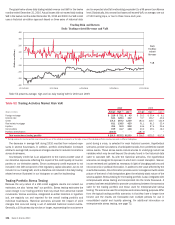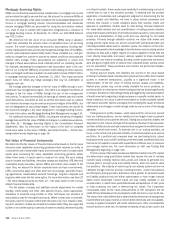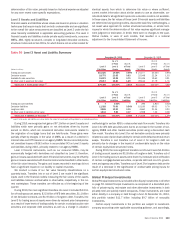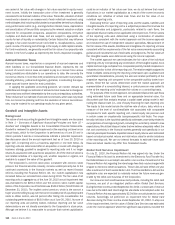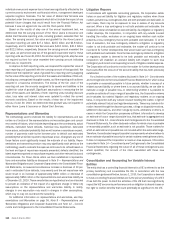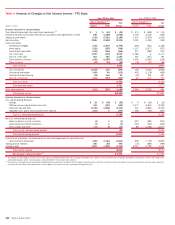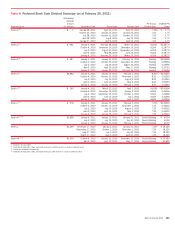Bank of America 2010 Annual Report Download - page 113
Download and view the complete annual report
Please find page 113 of the 2010 Bank of America annual report below. You can navigate through the pages in the report by either clicking on the pages listed below, or by using the keyword search tool below to find specific information within the annual report.issues, including mitigation plans, as appropriate. The goal of this process is
to assess changing market and business conditions, to evaluate key risks
impacting each line of business and enterprise control function and assess
the controls in place to mitigate the risks. The risk and control self assess-
ment process is documented at periodic intervals. Key operational risk
indicators for these risks have been developed and are used to help identify
trends and issues on an enterprise, line of business and enterprise control
function level.
The enterprise control functions participate in two ways to the operational
risk management process. First, these organizations manage risk in their
functional department. Second, they provide specialized risk management
services within their area of expertise to the enterprise and the lines of
business and other enterprise control functions they support. For example,
the Enterprise Information Management and Supply Chain Management
organizations in the Technology and Operations enterprise control function,
develop risk management practices, such as information security and supplier
management programs. These groups also work with business and risk
executives to develop and guide appropriate strategies, policies, practices,
controls and monitoring tools for each line of business and enterprise control
function relative to these programs.
Additionally, where appropriate, insurance policies are purchased to mit-
igate the impact of operational losses when and if they occur. These insurance
policies are explicitly incorporated in the structural features of operational risk
evaluation. As insurance recoveries, especially given recent market events,
are subject to legal and financial uncertainty, the inclusion of these insurance
policies are subject to reductions in their expected mitigating benefits.
Complex Accounting Estimates
Our significant accounting principles, as described in Note 1 – Summary of
Significant Accounting Principles to the Consolidated Financial Statements
are essential in understanding the MD&A. Many of our significant accounting
principles require complex judgments to estimate the values of assets and
liabilities. We have procedures and processes in place to facilitate making
these judgments.
The more judgmental estimates are summarized in the following discus-
sion. We have identified and described the development of the variables most
important in the estimation processes that, with the exception of accrued
taxes, involve mathematical models to derive the estimates. In many cases,
there are numerous alternative judgments that could be used in the process
of determining the inputs to the models. Where alternatives exist, we have
used the factors that we believe represent the most reasonable value in
developing the inputs. Actual performance that differs from our estimates of
the key variables could impact net income. Separate from the possible future
impact to net income from input and model variables, the value of our lending
portfolio and market sensitive assets and liabilities may change subsequent
to the balance sheet date, often significantly, due to the nature and magnitude
of future credit and market conditions. Such credit and market conditions may
change quickly and in unforeseen ways and the resulting volatility could have a
significant, negative effect on future operating results. These fluctuations
would not be indicative of deficiencies in our models or inputs.
Allowance for Credit Losses
The allowance for credit losses, which includes the allowance for loan and
lease losses and the reserve for unfunded lending commitments, represents
management’s estimate of probable losses inherent in the Corporation’s loan
portfolio excluding those loans accounted for under the fair value option.
Changes to the allowance for credit losses are reported in the Consolidated
Statement of Income in the provision for credit losses. Our process for
determining the allowance for credit losses is discussed in Note 1 – Summary
of Significant Accounting Principles to the Consolidated Financial Statements.
We evaluate our allowance at the portfolio segment level and our portfolio
segments are home loans, credit card and other consumer, and commercial.
Due to the variability in the drivers of the assumptions used in this process,
estimates of the portfolio’s inherent risks and overall collectability change
with changes in the economy, individual industries, countries, and borrowers’
or counterparties’ ability and willingness to repay their obligations. The degree
to which any particular assumption affects the allowance for credit losses
depends on the severity of the change and its relationship to the other
assumptions.
Key judgments used in determining the allowance for credit losses include
risk ratings for pools of commercial loans and leases, market and collateral
values and discount rates for individually evaluated loans, product type
classifications for consumer and commercial loans and leases, loss rates
used for consumer and commercial loans and leases, adjustments made to
address current events and conditions, considerations regarding domestic
and global economic uncertainty, and overall credit conditions.
Our estimate for the allowance for loan and lease losses is sensitive to the
loss rates and expected cash flows from our home loans, and credit card and
other consumer portfolio segments. For each one percent increase in the loss
rates on loans collectively evaluated for impairment in our home loans
portfolio segment excluding PCI loans, coupled with a one percent decrease
in the discounted cash flows on those loans individually evaluated for impair-
ment within this portfolio segment, the allowance for loan and lease losses at
December 31, 2010 would have increased by $141 million. PCI loans within
our home loans portfolio segment are initially recorded at fair value. Appli-
cable accounting guidance prohibits carry-over or creation of valuation allow-
ances in the initial accounting. However, subsequent decreases in the ex-
pected principal cash flows from the date of acquisition result in a charge to
the provision for credit losses and a corresponding increase to the allowance
for loan and lease losses. We subject our PCI portfolio to stress scenarios to
evaluate the potential impact given certain events. A one percent decrease in
the expected principal cash flows could result in a $297 million impairment of
the portfolio, of which $138 million would be related to our discontinued real
estate portfolio. For each one percent increase in the loss rates on loans
collectively evaluated for impairment within our credit card and other con-
sumer portfolio segment coupled with a one percent decrease in the expected
cash flows on those loans individually evaluated for impairment within this
portfolio segment, the allowance for loan and lease losses at December 31,
2010 would have increased by $152 million.
Our allowance for loan and lease losses is sensitive to the risk ratings
assigned to loans and leases within our Commercial portfolio segment.
Assuming a downgrade of one level in the internal risk ratings for commercial
loans and leases, except loans and leases already risk-rated Doubtful as
defined by regulatory authorities, the allowance for loan and lease losses
would have increased by $6.7 billion at December 31, 2010. The allowance
for loan and lease losses as a percentage of total loans and leases at
December 31, 2010 was 4.47 percent and this hypothetical increase in the
allowance would raise the ratio to 5.19 percent.
These sensitivity analyses do not represent management’s expectations
of the deterioration in risk ratings or the increases in loss rates but are
provided as hypothetical scenarios to assess the sensitivity of the allowance
for loan and lease losses to changes in key inputs. We believe the risk ratings
and loss severities currently in use are appropriate and that the probability of
the alternative scenarios outlined above occurring within a short period of
time is remote.
The process of determining the level of the allowance for credit losses
requires a high degree of judgment. It is possible that others, given the same
information, may at any point in time reach different reasonable conclusions.
Bank of America 2010 111







